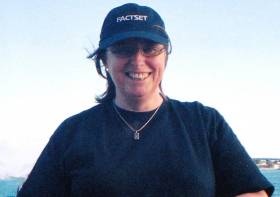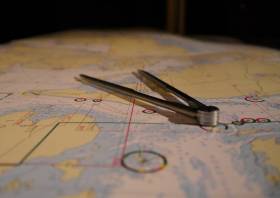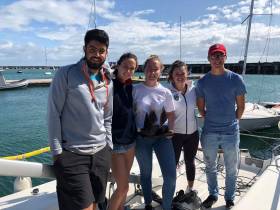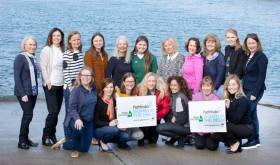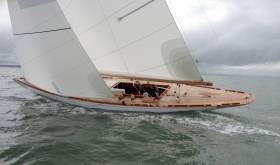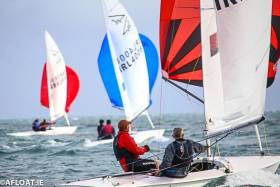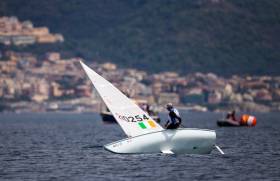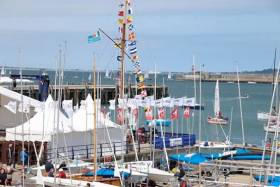Displaying items by tag: nyc
National Yacht Club Begins Celebrations For Its 150th Anniversary
The first of 2020’s wine suppers, held on Wednesday 15 January, kicked off the National Yacht Club’s 150th anniversary celebrations.
This follows the launching at Christmas of the splendid Sesquicentennial Anniversary gin and wines, which have been hugely popular with fellow members.
Post-Commodore Ronan Beirne chairs the Sesquicentennial Organising Committee and its remit covers House, Sailing, Building and Legacy aspects.
On the water, the Sesquicentennial Regatta, supported by Davy, will be a major five-day gathering, the Notice of Race for which has been put together by race director Con Murphy and his team.
The NYC is working with Royal Cork Yacht Club and Cove Sailing Club to pull together a Kingstown-to-Queenstown race which would celebrate RCYC’s 300th anniversary and the NYC’s 150th in a combined nautical endeavour, with a vintage flavour.
A 150-year history of the National Yacht Club is under way, written by DBSC stalwart Donal O’Sullivan and contributors. It is in the final stages of preparation and any members with significant memorabilia, stories and photographs might send them to [email protected] for consideration.
If funds allow, the club will have a Legacy Capital Project which will involve beautifying the front of the club — façade, railings and front garden area — being mindful that the clubhouse is a protected structure.
The special events schedule for 2020 is as follows:
- Saturday 29 February: Sailing Awards Dinner
- Saturday 28 March: Sesquicentennial Black Tie Gala Dinner
- Saturday 18 April: Street Food Festival and Musical Celebration
- Saturday 23 May: Spanish Tapas Evening
- Wednesday 10 June: Sesquicentennial Regatta Extravaganza begins
- Sunday 14 June: 150th Anniversary Regatta Extravaganza
- Saturday 4 July: American-Themed Cook-Out, BBQ and Entertainment
- Saturday 19 September: Street Food Festival Evening
- Saturday 31 October: Fancy dress themed Gala Dinner
- Saturday 14 November: Italian Opera Dinner
- Thursday 31 December: New Year’s Eve Gala Dinner
Cake & Gear Sale For National Yacht Club Juniors This Afternoon
Be sure to visit the National Yacht Club in Dun Laoghaire this afternoon (Sunday 24 November) for the junior section’s Bring & Buy Cake and Gear Sale from 12-2pm.
If you’ve been doing a clear-out of any unwanted gear or gear that you’ve outgrown, this is a great opportunity to sell or to buy some much loved gear for your own sailor.
Cake donations are also welcome, and the club promises coffee will be available!
Meanwhile, there’s still time to make plans for the NYC’s annual Junior Awards Dinner this coming Saturday 30 November.
Dinner for junior sailors starts at 7pm in the dining room, followed by prize giving and a disco until 10.30pm.
For parents, a social evening buffet meal with glass of wine will be offered in the JB Room from 7pm. The evening is €15 for juniors and €25 for parents to be pad on the night.
The widower of the late member Sue McDonnell has presented the National Yacht Club with a new perpetual trophy in her memory that will be recognise excellence in women’s sailing.
In agreement with her family and the NYC club committee, the Sue McDonnell Trophy will be awarded to the female club member who has contributed most to the advancement of women in sailing.
The NYC says the new award is timely as the club was selected to host the inaugural Irish Sailing Pathfinder Women at the Helm Regatta this year, and has been reconfirmed as host club in 2020.
Sue McDonnell who joined the club in 2002 when she and John Hall bought their Beneteau 31.7, 30 Something.
In 2007, having sold the Beneteau, she also co-owned the very successful J109 Something Else until her untimely death in 2014.
Sue started sailing out of Bray Sailing Club in the early 1960 and was for many years, and still is, a role model for gender equality and active women participation in our sport.
To nominate a fellow member for the new Sue McDonnell Trophy, or for any other existing Club Sailing Award, click HERE. The deadline for nominations has been extended to next Friday 29 November.
Thinking of chartering a boat abroad? Thinking of refreshing your navigation and chart work skills? Do you remember what lights vessels towing at night should show? Are you looking for something to do on wintery Monday nights?
There are many reasons why you should consider enrolling in an Enhanced International Certificate of Competency Course with the National Yacht Club in 2019/2020.
Theory courses for the International Certificate of Competency (ICC) will be held in the NYC during the coming winter months.
Each theory course will consist of five Monday evenings of tuition and one evening written test, with classes running for two-and-a-half hours from 7.15pm.
Course one begins on Monday 4 November and continues to Monday 9 December. Course two begins Monday 13 January and runs until Monday 17 February.
A minimum of four students are required for course to go ahead, with a maximum of 12 students per course to insure quality of tuition.
Big Results For Royal St George’s U25s In Women At The Helm Regatta
The Royal St George Yacht Club had reason to celebrate when members of the U25 squad took Class 1 and won the overall team prize in the Irish Sailing Pathfinder Women at the Helm Regatta this past weekend.
With Niamh Henry at the helm, Alanna Lyttle on main trim, Ellen Murray on pit, Roberta Bell King on bow and Gillian Ballesty on kite trim, the Class 1 team won both of their Saturday races on Dublin Bay in the event hosted by the neighbouring National Yacht Club.
“It was tough going but we worked well as a team and had some fun with the spinnaker in the big wind,” the crew said later.
The RSGYC also won the overall team prize with Helen O’Beirne in the Laser Radial and Grace O’Beirne in the 420.
Sligo Yacht Club’s sailors were the big winners on the day, as previously reported on Afloat.ie.
Entries are still open for the Irish Sailing Pathfinder Women at the Helm Regatta, hosted by the National Yacht Club on Saturday 17 and Sunday 18 August.
The event is open to PY dinghy and keelboat racing from Teens to Seniors. Full eligibility details are included in the Notice of Race.
The Perpetual Club Team Prize is open to all members of Irish Sailing affiliated clubs and there will be a wide range of category prizes.
Also planned for the weekend is a cruise in company with the Cruising Association of Ireland, as well as a Saturday night party in the NYC clubhouse.
This marks the first regatta held on a national level to celebrate women’s participation in Irish sailing, and interest may get a boost from news of Aisling Keller’s Olympic qualification for Tokyo 2020 in the Laser Radial.
Meanwhile, former Laser Radial competitor and Olympic silver medallist Annalise Murphy has spoken to The Irish Times about the challenges of her bid for Tokyo 2020 in the two-handed 49erFX with Katie Tingle.
For more on the Women at the Helm Regatta, read Gail McAllister’s write-up for Afloat.ie.
Whitbread Race competitor Angela Heath will join regular Dublin Bay helms Jean Mitton and Alison Clarke among the inspiring and influential Irish women taking part in the first Pathfinder Women at the Helm event next month.
This new event “encourages women to embrace a role of leadership on the water, and set an example for future female sailors so that helming becomes the norm”. Registration is open HERE.
Despite boys and girls competing against each other in single-handed dinghies, it’s still uncommon to see women leading their own crew, says Irish Sailing. Yet there are many strong women quietly pursuing their passion for sailing.
Among them is Jean Mitton of the Royal St George, who when she started out was often the only woman on a crew outside of family outings.
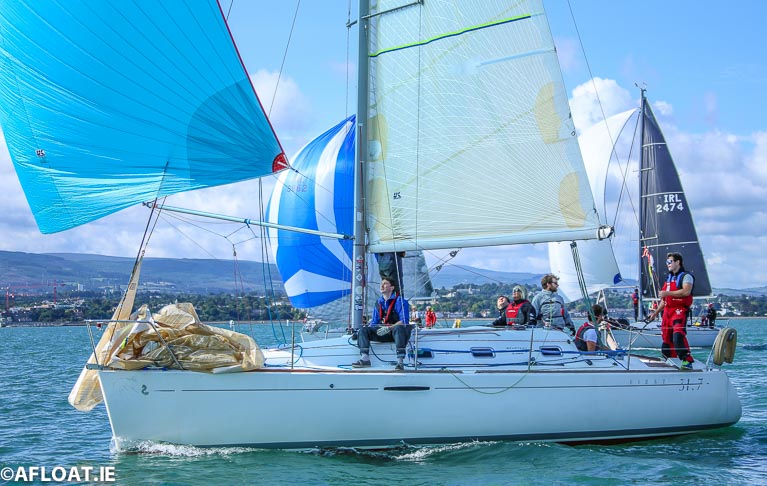 Jean Mitton (second from left) on board the family 31.7 Photo: Afloat
Jean Mitton (second from left) on board the family 31.7 Photo: Afloat
“Facing challenges while on the boat has given me the full sailing experience and made me confident in my ability to be at the helm,” says the now 12-year veteran.
 Alison Clarke (left) onboard the Quarter Tonner CrI Cri Photo: Afloat
Alison Clarke (left) onboard the Quarter Tonner CrI Cri Photo: Afloat
It’s a feeling shared by Alison Clarke, who will be helming the boat she regularly crews — Paul Colton’s Cri Cri — in the event over the weekend of Saturday 17 and Sunday 18 August at the National Yacht Club.
“Sailing has taught me things about leadership that you can’t learn in a classroom or from a textbook,” she says.
Both Jean and Alison surely took inspiration from the likes of Angela Heath, who was part of the pioneering all-woman crew of Tracy Edwards’ Maiden. And now they will have the opportunity to test their skills against Angela as she helms the Beneteau 31.7 Crazy Horse.
 The Beneteau 31.7 Crazy Horse with Angela Heath in white top, second from right Photo: Afloat
The Beneteau 31.7 Crazy Horse with Angela Heath in white top, second from right Photo: Afloat
Angela will also be taking part in a Q&A following a screening on Friday 16 August (National Yacht Club, 6.30pm) of the documentary Maiden, which charts the highs and lows of Edwards and crew in the 1989 edition of the world’s most challenging round-the-world sailing race.
National Yacht Club Issues Call For Volunteers To Assist With Class Compliance At Flying Fifteen Worlds
The National Yacht Club has issued a call for volunteers to assist in its hosting of the Flying Fifteen World Championships from 1-13 September.
As many as 86 boats expected to enter the event, which will take place 50 years after the first Flying Fifteens came to Dublin Bay and the National Yacht Club.
That means a huge task is at hand for all vessels to be measured and inspected for class rules compliance on the weekend of Saturday 31 August and Sunday 1 September, as well as on Thursday 5 September between the pre-Worlds and Worlds.
Volunteering to get involved in this task is being touted by the National as fun way to get involved and meet all the visitors coming from as far away as Hong Kong.
No previous experience as a measurer is required as class measurers will supervise the various stations (Control Desk, Weigh Station, Spars Inspection, Sails Measurement, Safety Checks).
If you’re free and able to lend a hand, fill in the online form HERE.
Finn Lynch Takes Fifth Overall In Thrilling Laser Final In Genoa
In a thrilling medal race final at the Hempel World Sailing Cup Series at Genoa, Finn Lynch from Carlow placed third this afternoon (Sunday 21 April) to claim fifth overall in the men’s single-handed Laser event.
The result marks the third consecutive major regatta for Lynch this year in which he finished in the top 10 of his event in the run-up to Tokyo 2020.
The National Yacht Club sailor entered the medal race final in seventh place overall with the possibility of a silver or bronze medal.
However, it was the sixth-placed Andrew Lewis, from Trinidad, who edged ahead into second place to took bronze, while Hungary’s Jonatan Vadnai placed fifth to win gold, with silver going to Pavlos Kontides who placed eighth in the final. Vadnai’s brother Benjamin won the final race and finished ninth overall.
In fact, any of the 10 finalists were potential medallists and the neck-and-neck race was reflected at the finishing-line with first to last places just 50 metres apart.
As light winds dominated the week at Genoa, so too was the final race sailed in near calm conditions.
“Finn started well, didn’t get into any trouble and sailed to his tactics – a straight race that he executed very well,” said Rory Fitzpatrick, Irish Sailing’s head coach.
“I’m delighted, seeing Finn come through from Toppers to Laser Radial then medalling at Youth Worlds and now contending for medals at senior level is outstanding.”
Ireland has still to qualify in the men’s single-handed Laser event for the Tokyo 2020 Olympics, with the next opportunity at the class world championships at the Olympic venue in Enoshima, Japan this July.
National Yacht Club Holding Easter Monday Event To Mark 70th Anniversary Of Republic
The National Yacht Club will be holding a small club event at noon tomorrow (Easter Monday, 22 April) to commemorate the 70th anniversary of the Republic of Ireland.
This event will take place at the front of the club before retiring to the dining room.
The commemoration marks the occasion when the Tricolour was raised by Pierce Purcell, then Commodore of the NYC and Commander of the Maritime Inscription (now the Navy Reserve), on Easter Monday 1949.
Current members of the Navy Reserve will hoist the Tricolour at front of house at the event, which is expected to be attended by Pierce Purcell Jr.
Guests will then retire to the dining room for tea and sandwiches, as well as to hear of the contribution of the NYC club to the Maritime Inscription.




























